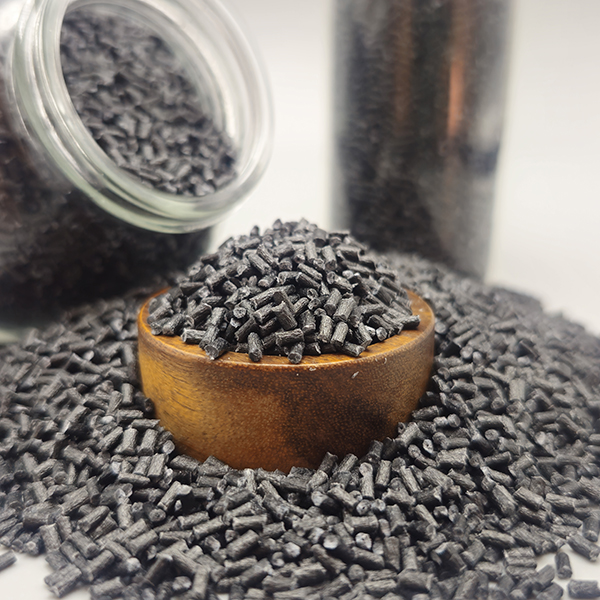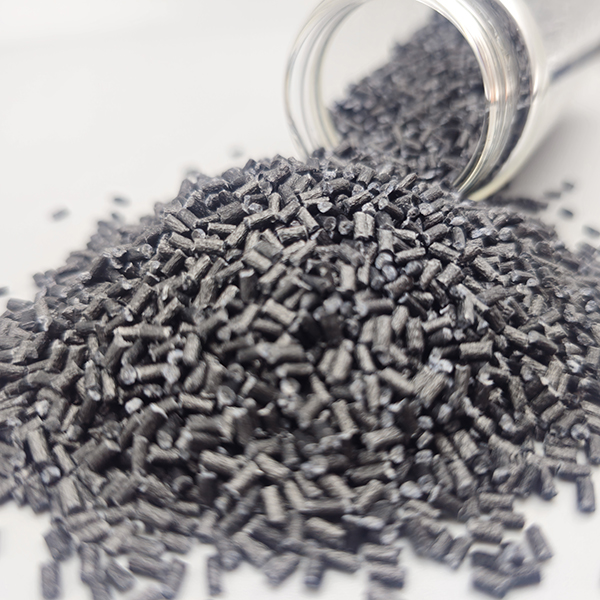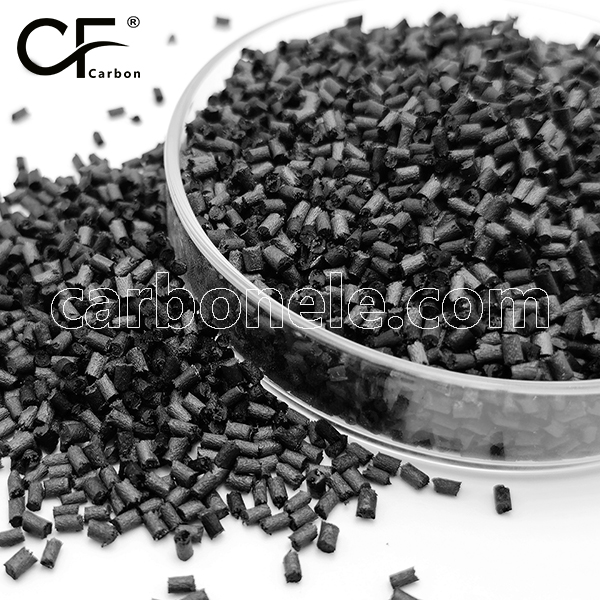
Conductive ABS CF40 Composite Supplier
ABS CF40 refers to a specific type of 3D printing filament that combines ABS (Acrylonitrile Butadiene Styrene) with 40% carbon fiber. Here’s a breakdown of what each component brings to the material:
- ABS (Acrylonitrile Butadiene Styrene):
- ABS is a common thermoplastic known for its toughness, impact resistance, and heat resistance.
- It is widely used in various industries for its balance of strength and flexibility.
- Carbon Fiber:
- Carbon fiber is a strong, lightweight material that enhances the mechanical properties of ABS when combined.
- It provides stiffness, strength, and improved dimensional stability to the filament.
- Model: ABS-CF-BCA4
- Filler: Carbon Fiber
- Features: Thermoplastic, Conductive, Recyclable, etc.
- Manufacturer: Yes
- Sample: Available
- MOQ: 1000kg
What’s ABS CF40?
ABS CF40 typically refers to ABS (Acrylonitrile Butadiene Styrene) filament that is infused with 40% carbon fiber. This infusion enhances the filament’s mechanical properties, making it stronger, stiffer, and more heat-resistant compared to standard ABS. Here are some key points about conductive ABS CF40:
1. **Material Composition**: It is primarily ABS plastic infused with 40% carbon fiber. The carbon fiber provides conductivity and improves the filament’s strength and rigidity.
2. **Conductivity**: Carbon fiber additives in ABS CF40 make it electrically conductive to some degree. This conductivity is useful in applications requiring static dissipation or where electrical conductivity is necessary.
3. **Mechanical Properties**: ABS CF40 exhibits enhanced mechanical properties compared to regular ABS. It is stronger, more impact-resistant, and stiffer, which makes it suitable for applications requiring durability and strength.
4. **Printability**: Printing with ABS CF40 may require adjustments compared to standard ABS due to the carbon fiber content. It can be more abrasive to 3D printer nozzles, requiring either hardened nozzles or frequent replacements.
5. **Applications**: Common applications for conductive ABS CF40 include functional prototypes, tools, jigs, and fixtures where strength, rigidity, and electrical conductivity are required. It is also used in environments where static electricity needs to be managed or dissipated.
6. **Post-Processing**: Like standard ABS, parts printed with ABS CF40 can be sanded, painted, or solvent-welded after printing to achieve desired surface finishes or join multiple parts together.
7. **Considerations**: Due to the carbon fiber content, the filament may have a matte black appearance and can be more prone to warping during printing if not managed properly. It’s important to optimize print settings such as temperature, bed adhesion, and cooling to achieve successful prints.
Overall, conductive ABS CF40 is a specialized filament suitable for applications where both mechanical strength and electrical conductivity are required, offering advantages over standard ABS in terms of performance and functionality.
Development Trends of ABS CF40
The future of ABS CF40 and similar composite materials appears promising, driven by ongoing advancements in additive manufacturing and material science. Here are some potential future directions for ABS CF40:
1. **Improved Formulations**: Manufacturers may continue to refine the formulation of ABS CF40 to enhance its properties further, such as improving printability, reducing warping, and optimizing conductivity.
2. **Broader Application Range**: As awareness of composite materials grows, ABS CF40 could find applications in new industries and fields beyond its current uses. This could include aerospace, automotive, electronics, and medical sectors where both mechanical strength and electrical conductivity are critical.
3. **Customization and Tailoring**: There might be developments in allowing users to customize the properties of ABS CF40 even more, such as adjusting the carbon fiber content or adding other additives to meet specific application requirements.
4. **Integration with Advanced Manufacturing Technologies**: ABS CF40 could be integrated with other advanced manufacturing technologies like multi-material printing or hybrid manufacturing processes to create parts with complex geometries and varied material properties.
5. **Sustainability and Recycling**: There could be efforts to improve the sustainability of ABS CF40 by using recycled carbon fibers or developing methods for easier recycling of printed parts, aligning with broader trends towards sustainable manufacturing practices.
6. **Standardization and Accessibility**: As with any emerging material, efforts towards standardization of printing parameters, material characteristics, and quality control will likely continue to make ABS CF40 more accessible and reliable for a wider range of users and applications.
Overall, the future of ABS CF40 hinges on ongoing innovation in material science and additive manufacturing technologies, as well as the evolving needs of industries seeking high-performance materials with specific mechanical and electrical properties.
Content Block 1
Morbi iaculis at quam vel faucibus. Ut semper ipsum ex, quis aliquet justo pretium a. Suspendisse scelerisque metus augue, a interdum leo iaculis sed. Vivamus sit amet nunc odio. Duis vel pulvinar dolor, at lacinia tellus.
Pellentesque habitant morbi tristique senectus et netus et malesuada fames ac turpis egestas. Suspendisse lacinia quam a elit lobortis tempor


Content Block 1
Morbi iaculis at quam vel faucibus. Ut semper ipsum ex, quis aliquet justo pretium a. Suspendisse scelerisque metus augue, a interdum leo iaculis sed. Vivamus sit amet nunc odio. Duis vel pulvinar dolor, at lacinia tellus.
Pellentesque habitant morbi tristique senectus et netus et malesuada fames ac turpis egestas. Suspendisse lacinia quam a elit lobortis tempor

Frequently Asked Questions
Carbon (Xiamen) New Material Co., Ltd. aims to provide buyers with "one-stop" worry-free high-quality services. Here you can find all information about carbon fiber engineering plastics. If you still have questions, please send us an email for consultation!
-
How can I contact the manufacturer of a product that interests me?
When you find a product you are interested in, you can contact the manufacturer directly by sending an email and we will get back to you as soon as possible.
-
How do I find the products that interest me?
All you need to do is enter the keyword, product name in the search window and press the Enter key on your keyboard. Your search results page will then be displayed. You can also search within the product category pages on the home page. Each category is divided into subcategories, allowing you to refine your search and find products that interest you.
-
Where will I find a buying guide?
Please contact our after-sales service directly and we will provide you with a comprehensive operating guide.
-
What are CF Reinforced Thermoplastic Composites?
CF Reinforced Thermoplastic Composites are materials where carbon fibers are incorporated into a thermoplastic matrix. They combine the strength and stiffness of carbon fibers with the processability and recyclability of thermoplastics. For instance, they are used in automotive parts like bumper beams.
-
What are the benefits of CF Reinforced Thermoplastic Composites over traditional composites?
The key benefits include faster production cycles, easier recyclability, and better impact resistance. They also offer design flexibility. An example is in the manufacturing of consumer electronics casings where complex shapes can be achieved more easily.
-
How are CF Reinforced Thermoplastic Composites processed?
Common processing methods include injection molding, extrusion, and compression molding. Injection molding is widely used for mass production. For example, in the production of small components for the medical industry.
-
What industries use CF Reinforced Thermoplastic Composites?
They are utilized in aerospace, automotive, medical, and sports equipment industries. In aerospace, they can be found in interior components. In the medical field, they might be used in prosthetics.
-
How does the carbon fiber content affect the properties of the composites?
Higher carbon fiber content generally leads to increased strength and stiffness but may reduce ductility. A moderate content is often balanced for specific applications. For example, a higher content might be preferred in structural parts of a race car.
-
What are the challenges in using CF Reinforced Thermoplastic Composites?
Challenges include higher material costs, complex processing equipment requirements, and ensuring uniform fiber dispersion. Issues with adhesion between the fibers and the matrix can also arise. An example is in achieving consistent quality in large-scale production.

























